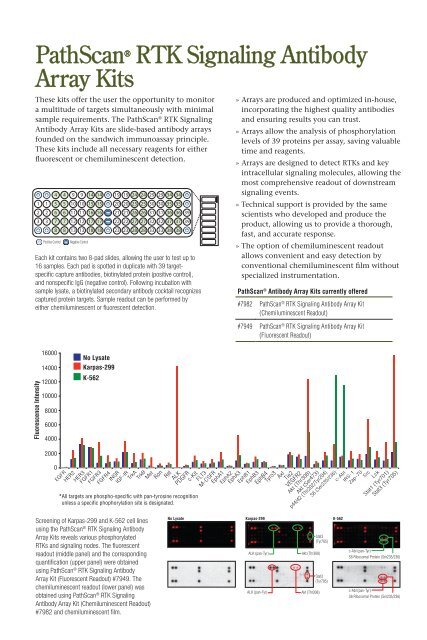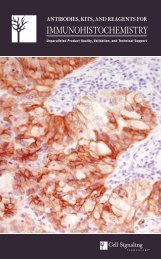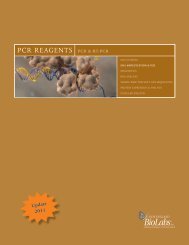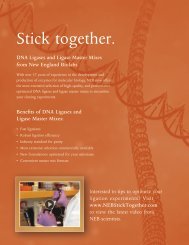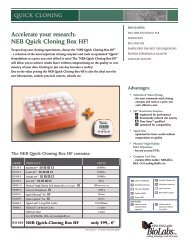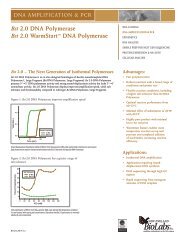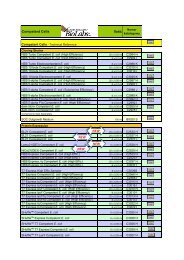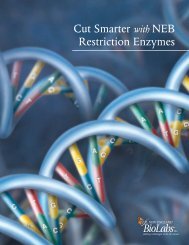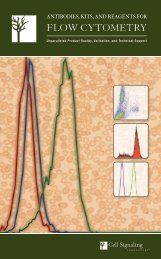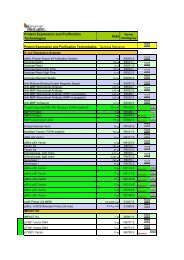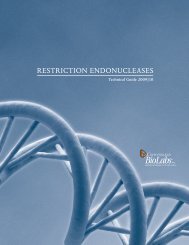PathScan® ELISA Products and Cellular Analysis Tools - Lab-JOT
PathScan® ELISA Products and Cellular Analysis Tools - Lab-JOT
PathScan® ELISA Products and Cellular Analysis Tools - Lab-JOT
Create successful ePaper yourself
Turn your PDF publications into a flip-book with our unique Google optimized e-Paper software.
PathScan ® RTK Signaling Antibody<br />
Array Kits<br />
These kits offer the user the opportunity to monitor<br />
a multitude of targets simultaneously with minimal<br />
sample requirements. The PathScan ® RTK Signaling<br />
Antibody Array Kits are slide-based antibody arrays<br />
founded on the s<strong>and</strong>wich immunoassay principle.<br />
These kits include all necessary reagents for either<br />
fluorescent or chemiluminescent detection.<br />
4 4 9 9 14 14 19 19 24 24 29 29 34 34<br />
1 1 5 5 10 10 15 15 20 20 25 25 30 30 35 35<br />
2 2 6 6 11 11 16 16 21 21 26 26 31 31 36 36 39<br />
3 3 7 7 12 12 17 17 22 22 27 27 32 32 37 37 39<br />
8 8 13 13 18 18 23 23 28 28 33 33 38 38<br />
Positive Control<br />
Negative Control<br />
Each kit contains two 8-pad slides, allowing the user to test up to<br />
16 samples. Each pad is spotted in duplicate with 39 targetspecific<br />
capture antibodies, biotinylated protein (positive control),<br />
<strong>and</strong> nonspecific IgG (negative control). Following incubation with<br />
sample lysate, a biotinylated secondary antibody cocktail recognizes<br />
captured protein targets. Sample readout can be performed by<br />
either chemiluminescent or fluorescent detection.<br />
» Arrays are produced <strong>and</strong> optimized in-house,<br />
incorporating the highest quality antibodies<br />
<strong>and</strong> ensuring results you can trust.<br />
» Arrays allow the analysis of phosphorylation<br />
levels of 39 proteins per assay, saving valuable<br />
time <strong>and</strong> reagents.<br />
» Arrays are designed to detect RTKs <strong>and</strong> key<br />
intracellular signaling molecules, allowing the<br />
most comprehensive readout of downstream<br />
signaling events.<br />
» Technical support is provided by the same<br />
scientists who developed <strong>and</strong> produce the<br />
product, allowing us to provide a thorough,<br />
fast, <strong>and</strong> accurate response.<br />
» The option of chemiluminescent readout<br />
allows convenient <strong>and</strong> easy detection by<br />
conventional chemiluminescent film without<br />
specialized instrumentation.<br />
PathScan ® Antibody Array Kits currently offered<br />
#7982 PathScan ® RTK Signaling Antibody Array Kit<br />
(Chemiluminescent Readout)<br />
#7949 PathScan ® RTK Signaling Antibody Array Kit<br />
(Fluorescent Readout)<br />
Fluorescence Intensity<br />
16000<br />
14000<br />
12000<br />
10000<br />
8000<br />
6000<br />
4000<br />
2000<br />
0<br />
EGFR<br />
HER2<br />
No Lysate<br />
Karpas-299<br />
K-562<br />
HER3<br />
FGFR1<br />
FGFR3<br />
FGFR4<br />
INSR<br />
IGF-IR<br />
TrkA<br />
TrkB<br />
Met<br />
Ron<br />
*All targets are phospho-specific with pan-tyrosine recognition<br />
unless a specific phophorylation site is designated.<br />
Screening of Karpas-299 <strong>and</strong> K-562 cell lines<br />
using the PathScan ® RTK Signaling Antibody<br />
Array Kits reveals various phosphorylated<br />
RTKs <strong>and</strong> signaling nodes. The fluorescent<br />
readout (middle panel) <strong>and</strong> the corresponding<br />
quantification (upper panel) were obtained<br />
using PathScan ® RTK Signaling Antibody<br />
Array Kit (Fluorescent Readout) #7949. The<br />
chemiluminescent readout (lower panel) was<br />
obtained using PathScan ® RTK Signaling<br />
Antibody Array Kit (Chemiluminescent Readout)<br />
#7982 <strong>and</strong> chemiluminescent film.<br />
Ret<br />
ALK<br />
PDGFR<br />
c-Kit<br />
FLT3<br />
M-CSFR<br />
EphA1<br />
EphA2<br />
EphA3<br />
EphB1<br />
EphB3<br />
EphB4<br />
Tyro3<br />
Axl<br />
Tie2<br />
VEGFR2<br />
Akt (Thr308)<br />
p44/42 (Thr202/Tyr204)<br />
Akt (Ser473)<br />
No Lysate Karpas-299<br />
K-562<br />
ALK (pan-Tyr)<br />
ALK (pan-Tyr)<br />
Akt (Thr308)<br />
Akt (Thr308)<br />
Stat3<br />
(Tyr705)<br />
Stat3<br />
(Tyr705)<br />
S6 (Ser235/236)<br />
c-Abl<br />
IRS-1<br />
Zap-70<br />
Src<br />
Lck<br />
Stat1 (Tyr701)<br />
Stat3 (Tyr705)<br />
c-Abl (pan-Tyr)<br />
S6 Ribosomal Protein (Ser235/236)<br />
c-Abl (pan-Tyr)<br />
S6 Ribosomal Protein (Ser235/236)


